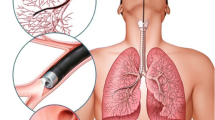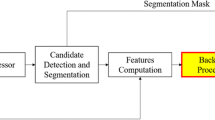Abstract
We adopted decision fusion techniques to develop a computer-aided detection (CAD) system for automatic detection of pulmonary nodules in low-dose CT images. Two distinct phases, aimed, respectively, at detecting volumes of interests (VOIs) within the CT scan, and at classifying VOIs into nodules and non-nodules, were considered. Three algorithms, namely thresholding, region growing and robust fuzzy clustering, were used as VOI detectors. For the classification phase, we built multi-classifier systems, which aggregate the decisions of three statistical classifiers, a neural network and a decision tree. Finally, the receiver operating characteristic convex hull method was used to build the final classifier, which results to be the aggregation of the best local behaviors of both classifiers and combiners. All the CAD modules were tested on CT scans analyzed by two expert radiologists. In the experiments, we achieved a sensitivity of 92.5% against a specificity of 83.5%.




















Similar content being viewed by others
References
Sone S et al (1998) Mass screening for lung cancer with mobile spiral computed tomography scanner. Lancet 351:1242–1245
Swensen SJ et al (2002) Screening for lung cancer with low-dose spiral computed tomography. Am J Respir Crit Care Med 165(4):508–513
Armato SG III (2003) CAD dissects growing volume of data from lung CT exams. http://www.diagnosticimaging.com/advancedct2003/
Flehinger BJ et al (1984) Early lung cancer detection: results of the initial (prevalence) radiologic and cytologic screening in the Memorial Sloan-Kettering study. Am Rev Respir Dis 140:555–560
Awai K et al (2004) Pulmonary nodules at chest CT: effect of computer-aided diagnosis on radiologists’ detection performance. Radiology 230(2):347–352
van Klaveren RJ et al (2001) Lung cancer screening by low-dose spiral computed tomography. Eur Respir J Suppl 18(5):857–866
Dalrymple-Hay MJR, Drury NE (2001) Screening for lung cancer. J R Soc Med 94:2–5
Gurcan MN et al (2002) Lung nodule detection on thoracic computed tomography images: preliminary evaluation of a computer-aided diagnosis system. Med Phys 29(11):2552–2558
Armato SG III, Giger ML, MacMahon H (2001) Automated detection of lung nodules in CT scans: preliminary results. Med Phys 28(8):1552–1561
Lee Y, Hara T, Fujita H, Itoh S, Ishigaki T (2001) Automated detection of pulmonary nodules in helical CT images based on an improved template-matching technique. IEEE Trans Med Imaging 20(7):595–604
Dehmeshki J, Ye X, Lin X-Y, Valdivieso M, Amin H (2007) Automated detection of lung nodules in CT images using shape-based genetic algorithm. Comput Med Imaging Graph 31:408–417
Arimura H, Katsuragawa S, Suzuki K, Li F, Shiraishi J, Sone S, Doi K (2004) Computerized scheme for automated detection of lung nodules in low-dose computed tomography images for lung cancer screening. Acad Radiol 11:617–629
Bellotti R et al (2007) A CAD system for nodule detection in low-dose lung CTs based on region growing and a new active contour model. Med Phys 34(12):4901–4910
Armato SG III, Sensakovic WF (2004) Automated lung segmentation for thoracic CT impact on computer diagnosis. Acad Radiol 11(9):1011–1021
Brown MS et al (1997) Method for segmenting chest CT image data using an anatomical model: preliminary results. IEEE Trans Med Imaging 16(6):828–839
Brown MS, Mc-Nitt-Gray MF, Goldin JG, Suh RD, Sayre JW, Aberle DR (2001) Patient-specific models for lung nodule detection and surveillance in CT images. IEEE Trans Med Imaging 20(12):1242–1250
Rote G (1991) Computing the minimum Hausdorff distance between two point sets on a line under translation. Inform Process Lett 38:123–127
Sluimer I, Prokop M, van Ginneken B (2005) Toward automated segmentation of the pathological lung in CT. IEEE Trans Med Imaging 24(8):1025–1038
Pham DL (2001) Spatial models for fuzzy clustering. Comput Vis Image Underst 84:285–297
Bezdek JC (1981) Pattern recognition with fuzzy objective algorithms. Plenum Press, New York, p 1981
Gonzalez RC, Woods RE (2002) Digital image processing, 2nd edn. Prentice Hall, New Jersey, pp 600–615
Jain A, Duin R, Mao J (2000) Statistical pattern recognition: a review. IEEE Trans Pattern Anal Mach Intell 22(1):4–37
Fukunaga K (1990) Introduction to statistical pattern recognition, 2nd edn. Academic Press, New York
Safavian SR, Landgrebe D (1991) A survey of decision tree classifier methodology. IEEE Trans Syst Man Cybern 21(3):660–674
Buhmann MD (2003) Radial basis functions. Cambridge University Press, Cambridge
Duin RPW (2007) PRTools (Version 4.0), a Matlab toolbox for pattern recognition. Pattern recognition group, Delft University of Technology, Delft
Yager RR (1988) On ordered weighted averaging aggregation operators in multi-criteria decision making. IEEE Trans Syst Man Cybern 18:183–190
Kuncheva LI, Bezdek JC, Duin RPW (2001) Decision templates for multiple classifier fusion: an experimental comparison. Pattern Recognit 34(2):299–314
Kuncheva LI, Bezdek JC, Sutton MA (1998) On combining multiple classifiers by fuzzy templates. In: Proceedings of Nafips’98, FL, pp 193–197
Xu L, Krzyzak A, Suen CY (1992) Methods of combining multiple classifiers and their application to handwritten recognition. IEEE Trans Syst Man Cybern 22:418–435
Cococcioni M, Lazzerini B, Marcelloni F (2004) A TSK fuzzy model for combining outputs of multiple classifiers. In: Proceedings of the 2004 annual meeting of the North American fuzzy information processing society, vol 2, pp 871–876
Provost F, Fawcett T (2001) Robust classification for imprecise environments. Mach Learn 42(3):203–231
Provost F, Fawcett T (1997) Analysis and visualization of classifier performance: comparison under imprecise class and cost distributions. In: Proceedings of third international conference on knowledge discovery and data mining (KDD-97). AAAI Press, Menlo Park, pp 43–48
Adams NM, Hand DJ (1999) Comparing classifiers when the misallocation costs are uncertain. Pattern Recognit 32(7):1139–1147
Author information
Authors and Affiliations
Corresponding author
Rights and permissions
About this article
Cite this article
Antonelli, M., Cococcioni, M., Lazzerini, B. et al. Computer-aided detection of lung nodules based on decision fusion techniques. Pattern Anal Applic 14, 295–310 (2011). https://doi.org/10.1007/s10044-011-0219-9
Received:
Accepted:
Published:
Issue Date:
DOI: https://doi.org/10.1007/s10044-011-0219-9




